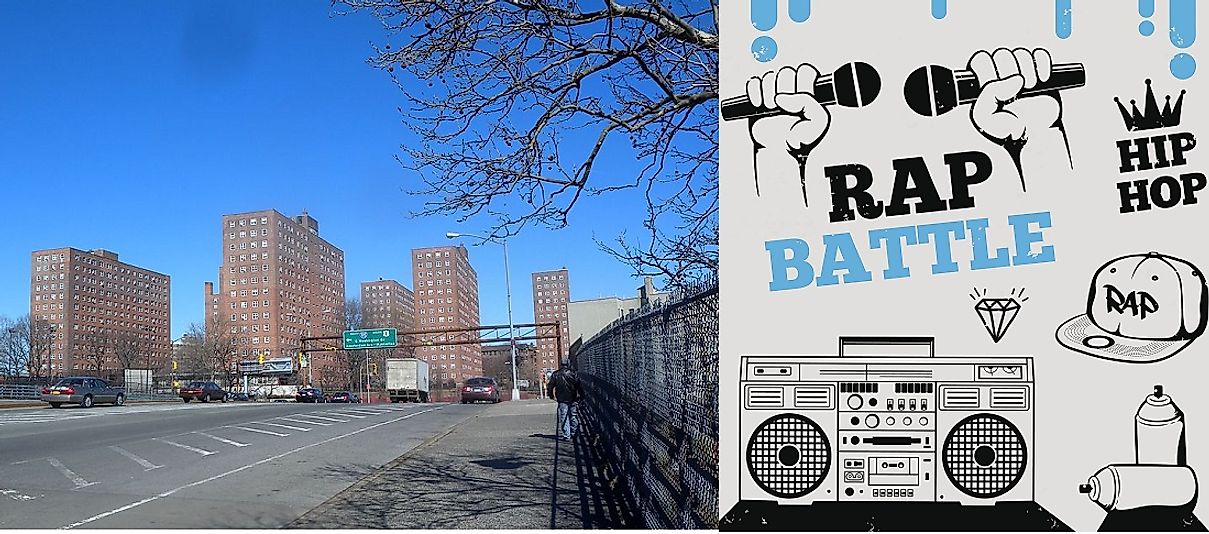Where Did Rap And Hip Hop Music Come From?

Words arranged to be uttered synchronized with music can have awesome power when it comes to influencing a person or society. Music has evolved over centuries with the development of several music genres. While some music genres like blues and acapella have adopted the slow non-violent rhythms, other genres such as reggae and hip-hop are associated with high energy and intense activities including dancing and singing. Hip hop culture is a part of art movement formed in the 1970s by the African-American youths.
5. Overview and Characteristics -
Hip hop, or rap, music consists of stylized rhythmic music which is performed alongside "rapping", a sort of chanted rhyming speech spoken in a rhythmic style. Hip hop music came about as a component of hip hop culture that include rapping, Disc Jockeying (DJ-ing), break dancing, and graffiti drawing. DJ-ing involves the manipulating of sounds and creating music using a DJ mixer and phonograph turntable. Emceeing, or rapping, involves rhyming lyrics with strong rhythmic accompaniment performed in time to the beat of the music while break dancing is a distinctive frenetic dance style. Thus, hip hop music incorporates these other elements of hip hop subculture. Hip hop music is characterized by songs that address the social injustices within a society and promotes a culture of equality. However, gangster rap which is part of hip hop music, highlights a violent lifestyle and the sorry conditions of the youths.
4. Origins -
Hip hop music was born in the 1970s at a period when block parties were becoming popular in the South Bronx neighborhoods of New York City, especially among African-American youths. The block parties were dominated by DJs whose playlists included funk and soul music. These DJs also began to play the occasional breaks of common music using the turntables to lengthen the break period. Rapping slowly developed with the artist speaking along the instrumental beats. Hip hop music diversified into more complex style with several artists developing interest in the genre. The term hip hop is attributed to Keith Cowboy who used it to tease a friend who had joined the US Army. He later adopted the hip hop stance as part of his stage performance.
3. Spread, Development, and Criticisms -
The diversification of the hip hop music genre began in the 1980s to include more involved and complex styles. Before the 1980s, the genre of music was confined in the US. However, it began spreading and became popular music in many countries. Due to the popularity of rap music, New school hip hop was born with early records of LL Cool J. The new school hip-hop was part of the golden age hip hop period which included innovation and creativity in producing hip hop music. Gangsta hip hop which focused on violent lifestyle among the youths also emerged in the late 1980s. In the 1990s, hip hop music started incorporating different styles including the southern rap. The popularity of hip hop continued through to the 2000s further influencing the mainstream pop. However, hip hop music is considered to be unnecessary noise with no clear message to the audience. Some of the rap artists include the use of vulgar language and cursing words in their songs that make some of the listeners uncomfortable.
2. Notable Rappers, Past and Present -
The hip hop music genre has been dominated by some of the most gifted artists of the recent past and present. Some of these artists include DJ Kool Herc who is the father of rap and Sugarhill Gang famous for their first single “Rapper’s Delight". The new school hip hop music in the 1980s was dominated by Run-DMC, LL Cool J, the late Big L, Snoop Dog, and Dr Dre. The modern hip hop stars include Kanye West, Eminem, Queen Latifah, and Will Smith, among other artists.
1. Cultural and Artistic Significance -
Early hip hop music is often credited with having reduced the numbers and influences of gangs which roamed the cities, as many gang members were seen abandoning physical fights and replacing them with hip hop battles. However, with the emergence of gangster hip hop music, artists have emphasized on use of drugs, weapons, and violence. Furthermore, women have often been marginalized with many of the songs produced by some Hip Hop artists by way of lyrics hyper-sexualizing and stereotyping women.







